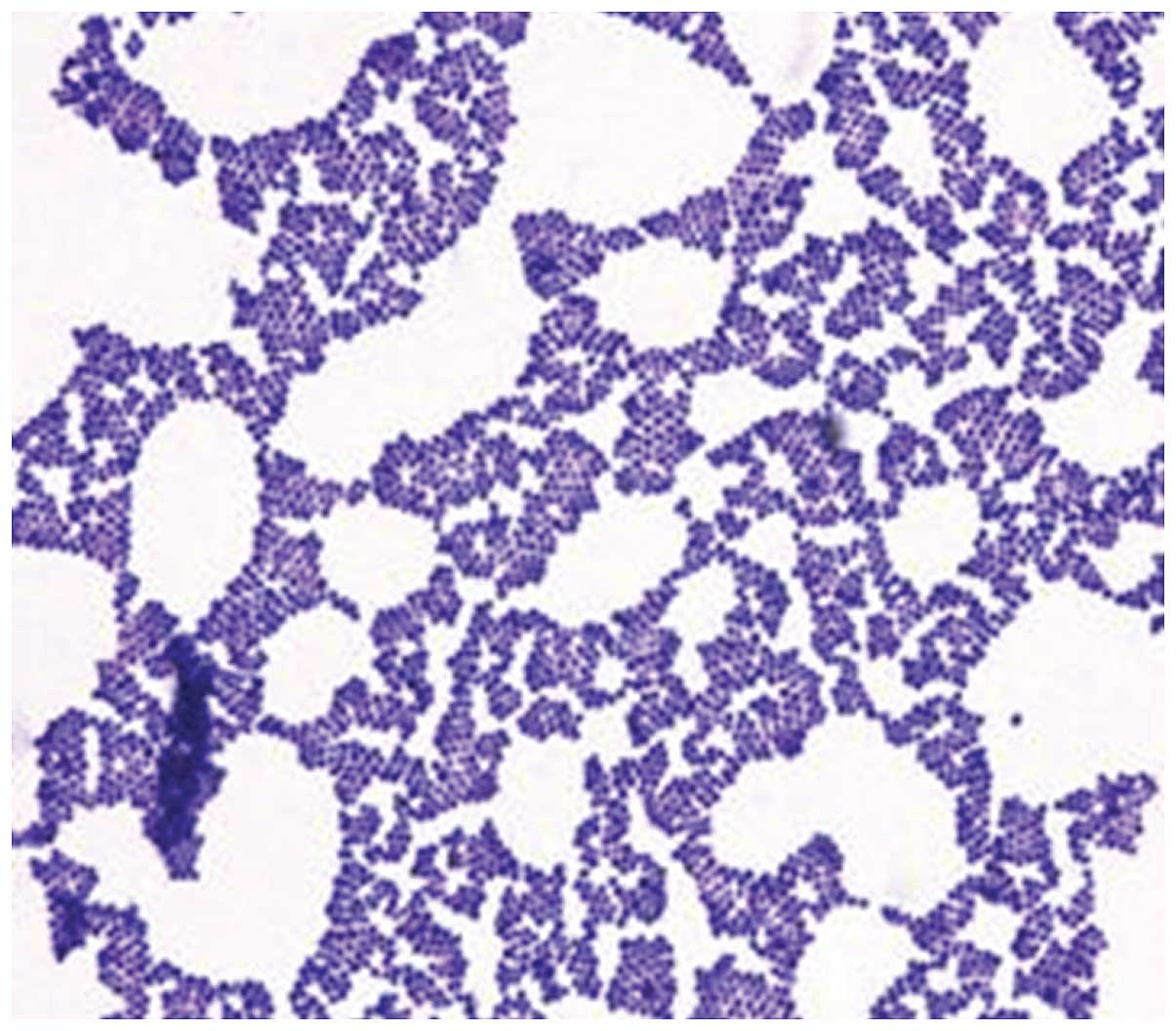|
1
|
Dong L, Zhang XY, Liu ZY, Jiang FL, Zhang
J and Wu YP: Analysis of Distribution and Drug Resistance of
Pathogens in the Infection Inpatients from Orthopedic Department of
Our Hospital during 2011–2013. China Pharm. 2:195–197. 2015.
|
|
2
|
Ramos-Luces O, Molina-Guillén N,
Pillkahn-Díaz W, Moreno-Rodríguez J, Vieira-Rodríguez A and
Gómez-León J: Surgical wound infection in general surgery. Cir Cir.
79:323–329. 2011.PubMed/NCBI
|
|
3
|
Wu XY, Ni KX and Li SB: Clinical
characteristics and resistance of wound surface infections causing
by Bacillus cereus in the department of orthopaedics. Zhongguo Gu
Shang. 26:753–756. 2013.(In Chinese). PubMed/NCBI
|
|
4
|
Bouza E, Burillo A, Munoz P, Cercenado E
and Rodríguez-Créixems M: Semiquantitative culture of open surgical
wounds for diagnosis of surgical site infection. Eur J Clin
Microbiol Infect Dis. 23:119–122. 2004. View Article : Google Scholar : PubMed/NCBI
|
|
5
|
Wysocki AB: Evaluating and managing open
skin wounds: Colonization versus infection. AACN Clin Issues.
13:382–397. 2002. View Article : Google Scholar : PubMed/NCBI
|
|
6
|
Zhao X: Pathogen analysis and clinical
prevention and treatment of inhospital postoperative infection of
aging patients in department of orthopedics. Practical Clinical
Medicine. 19:145–147. 2015.(In Chinese).
|
|
7
|
Bagga B and Shenep JL: Management of
infections caused by vancomycin-resistant gram-positive bacteria.
Pediatr Infect Dis J. 29:662–664. 2010. View Article : Google Scholar : PubMed/NCBI
|
|
8
|
O'Neill AJ: New antibacterial agents for
treating infections caused by multi-drug resistant Gram-negative
bacteria. Expert Opin Investig Drugs. 17:297–302. 2008. View Article : Google Scholar : PubMed/NCBI
|
|
9
|
Ii K, Ichikawa S, Al-Dabbagh B, Bouhss A
and Matsuda A: Function-oriented synthesis of simplified
caprazamycins: Discovery of oxazolidine-containing uridine
derivatives as antibacterial agents against drug-resistant
bacteria. J Med Chem. 53:3793–3813. 2010. View Article : Google Scholar : PubMed/NCBI
|
|
10
|
Li S and Ye G: Infection distribution of
Aureus and analysis on its drug resistance. J Chin Hosp Infect.
20:3045–3046. 2010.
|
|
11
|
Qiubao A and Aimin H: Clinical
distribution and drug resistance analysis of pseudomonas aeruginosa
in our hospital. Med Infant. 13:236–237. 2013.
|
|
12
|
Maltezou HC, Giakkoupi P, Maragos A,
Bolikas M, Raftopoulos V, Papahatzaki H, Vrouhos G, Liakou V and
Vatopoulos AC: Outbreak of infections due to KPC-2-producing
Klebsiella pneumoniae in a hospital in Crete (Greece). J
Infect. 58:213–219. 2009. View Article : Google Scholar : PubMed/NCBI
|
|
13
|
Gregory CJ, Llata E, Stine N, Gould C,
Santiago LM, Vazquez GJ, Robledo IE, Srinivasan A, Goering RV and
Tomashek KM: Outbreak of carbapenem-resistant Klebsiella
pneumoniae in Puerto Rico associated with a novel carbapenemase
variant. Infect Control Hosp Epidemiol. 31:476–484. 2010.
View Article : Google Scholar : PubMed/NCBI
|
|
14
|
Meunier O: From the discovery of
antibiotics to emerging highly drug-resistant bacteria. Soins.
797:14–20. 2015.(In French). View Article : Google Scholar : PubMed/NCBI
|
|
15
|
Selasi GN, Nicholas A, Jeon H, Lee YC, Yoo
JR, Heo ST and Lee JC: Genetic basis of antimicrobial resistance
and clonal dynamics of carbapenem-resistant Acinetobacter
baumannii sequence type 191 in a Korean hospital. Infect Genet
Evol. 36:1–7. 2015. View Article : Google Scholar : PubMed/NCBI
|
|
16
|
Kirkland KB, Briggs JP, Trivette SL,
Wilkinson WE and Sexton DJ: The impact of surgical-site infections
in the 1990s: Attributable mortality, excess length of
hospitalization, and extra costs. Infect Control Hosp Epidemiol.
20:725–730. 1999. View
Article : Google Scholar : PubMed/NCBI
|
|
17
|
Olsen MA, Nepple JJ, Riew KD, Lenke LG,
Bridwell KH, Mayfield J and Fraser VJ: Risk factors for surgical
site infection following orthopaedic spinal operations. J Bone
Joint Surg Am. 90:62–69. 2008. View Article : Google Scholar : PubMed/NCBI
|
|
18
|
Cole MR, Hobden JA and Warner IM:
Recycling antibiotics into GUMBOS: A new combination strategy to
combat multi-drug-resistant bacteria. Molecules. 20:6466–6487.
2015. View Article : Google Scholar : PubMed/NCBI
|
|
19
|
ter Pull Gunne AF, Hosman AJ, Cohen DB,
Schuetz M, Habil D, van Laarhoven CJ and van Middendorp JJ: A
methodological systematic review on surgical site infections
following spinal surgery: part 1: risk factors. Spine.
37:2017–2033. 2012. View Article : Google Scholar : PubMed/NCBI
|
|
20
|
Olsen MA, Butler AM, Willers DM, Devkota
P, Gross GA and Fraser VJ: Risk factors for surgical site infection
after low transverse cesarean section. Infect Control Hosp
Epidemiol. 29:477–484; discussion 485–486. 2008. View Article : Google Scholar : PubMed/NCBI
|
|
21
|
Ferronato AE, Gilio AE, Ferraro AA, Paulis
M and Vieira SE: Etiological diagnosis reduces the use of
antibiotics in infants with bronchiolitis. Clinics (Sao Paulo).
67:1001–1006. 2012. View Article : Google Scholar : PubMed/NCBI
|
















